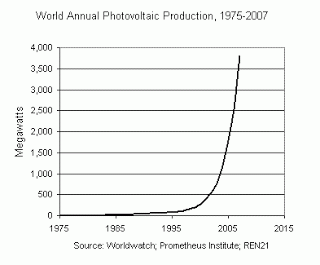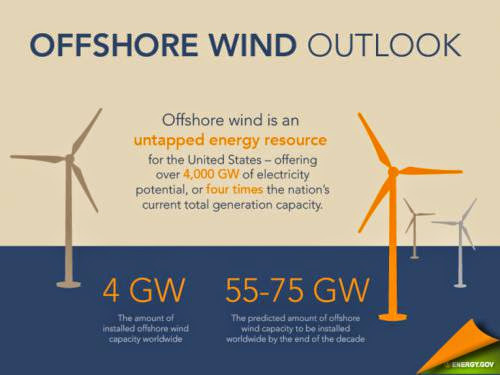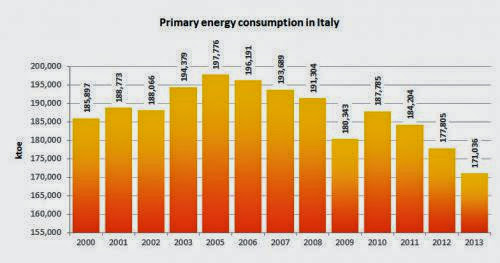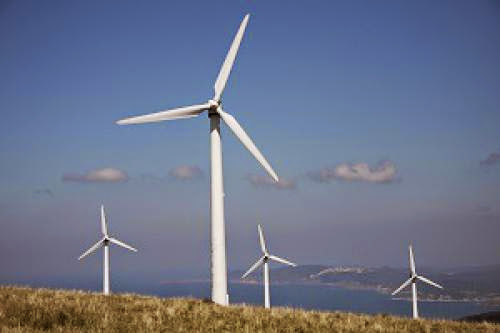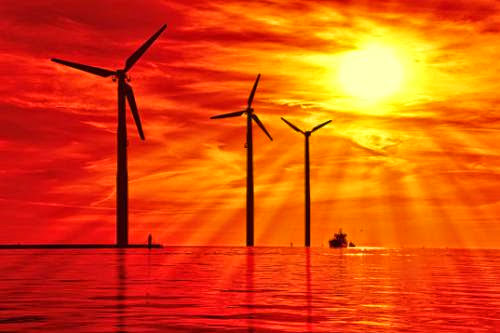Let me be brutally honest and say there is no major potential for wave power. Yes, of course, a few installations over the next few decades will successfully feed electricity into the local grid, but will wave power, say, approach 10% of all electricity produced by the year 2100? Even though it is reported that the theoretical amount of the available resource exceeds current worldwide usage, I think there are too many impacting negative factors facing this option. But I could be wrong, so let me attempt to provide a broad perspective.
"In my book focusing on renewable energy, SIMPLE SOLUTIONS FOR PLANET EARTH", I indicated that the UK estimated that 0.1% of the energy inherent in offshore waves could supply the world's energy needs five time over. However, I ended with:
"MY PERSONAL ASSESSMENT OF WAVE POWER IS TO WAIT AND SEE. I AM NOT OPTIMISTIC."
Part of my pessimism is based on failures. For example, the world's first wave farm just north of Porto, Portugal, went into operation in 2008, using three Pelamis wave energy converters. Just two months later, the effort collapsed. There is doubt about any second phase.
Thus, first, some contravening factors:"
* More than two decades ago I was on flight to Tonga with a researcher from the Florida Solar Energy Center. He was on his way to assess the potential of wave power for the country. He never survived his first survey dive. Last year it was reported that ARGOenvironmental of New Zealand was negotiating a power purchase agreement with Tonga for a 1 MW wave energy project.
* It will be nearly impossible for a wave energy system to survive a hundred year storm...UNLESS IT IS PROPERLY PROTECTED. And here is the fatal flaw. You can almost always build to withstand disaster. The Fukushima nuclear reactors (above") would have survived if the walls were thicker and 25 feet taller. But how can you justify such costs for something that has never before happened? Wavepower devices can be designed to withstand virtually anything, but that could double or triple the already high cost. Wind energy conversion devices have fallen apart. SIMPLY, WATER IS 859 TIMES DENSER THAN AIR.
* The local paper yesterday described a 20kW Azura wave buoy to be tested at the Wave Energy Test Site of the University of Hawaii off the Kaneohe Marine Corps Base. I have friends who have 20 kW solar photovoltaic installations on their roof. The maintenance is minimal. Can you imagine what it will cost to keep this system to the right going for 20 years? Then, of course, there will be days when there will be no waves.
* Energy Informative gives some pluses and minuses. The major bad is cost:
* Unknown, now high, but potential for competitiveness at larger scale and dependability.
* Maintenance.
A key question is what will it cost to produce electricity from a wave power system? A study reported by Dong-hyeon Park from Seoul National University indicates that:
* Oceanlinx's Oscillating Wave Column Plant someday will be able to generate electricity for 9.2 cents/kWh
* Pelami Wave Plant will ultimately do it for 10.4 cents/kWh
As electricity ranges from 33 cents/kWh on Oahu to 45 cents/kWh on Lanai, wow, why doesn't Hawaii immediately jump into wave energy? Wave energy is today still very expensive.
So returning to Dr. Park's assessment above, it is my contention that any developing renewable electrical generation system almost always at maturity and large scale will be projected to produce electricity for less than 10 cents/kWh. That is a general rule of future energy sources. Proponents can justifiably speculate to their advantage. When I first worked on fracking for the Lawrence Livermore National Laboratory in the 70's: "
* When oil sold for 3/barrel, we said, if only oil prices were to double, we could produce cost-effectively.
* With the energy crises, oil shot up to 10/barrel.
* We then indicated, if petroleum came up to 12/barrel, surely, our fracking system would be competitive.
* Well, oil is now somewhere north of 100/barrel, and fracking, indeed, is a success.
* I might add that I then went on to work for the U.S, Senate in 1979, and was instrumental in passing various pieces of legislation promoting fracking, something that I today regret. (READ the paragraph to the right of Senator Scoop Jackson--after you click on that")
There are two points to underscore here:
* Never accept the future cost of any energy source as cost-effective if provided by an advocate of the resource.
* On the other hand, they could be right should conditions significantly change to their advantage. If global warming becomes a true crisis, a severe carbon tax will be invoked. Then, some of the more marginal options will definitely be commercialized. It is, thus, worthwhile to have various alternatives ready for implementation.
"A compilation of negatives from Conserve Energy Future:
* Only suitable for certain locations
* Effect of marine ecosystem
* Source of disturbance for private and commercial vessels (I might add, surfers")
* Wavelength
* Weak performance in rough weather ("and, I might add, potentially cataclysmic")
* Noise and visual pollution ("I can't imagine what would be the noise pollution")
"Among the favorable points for wave energy include:
* The capacity factor (% of time energy is supplied divided by nameplate figure") could be as high as 40%
* solar photovoltaic in Arizona = 20% ("the sun does not shine all the time")
* windfarms = 20% - 40%
* coal power plants = 40% - 70%
* nuclear reactor = 70%-90%
* Zero carbon dioxide emission
* From Conserve Energy Future
* Renewable
* Environmentally friendly
* Abundant and widely available
* Variety of mechanisms
* Predictable
* Less dependency on foreign oil
* No damage to land
So what should be the strategy for wave power? Universities should continue to provide wave energy test centers to assist companies and the federal governments of the world should provide supportive funds. In consideration of the enormity of our future energy and environmental problems anticipated, even wave power deserves some consideration.
I reported on the Hawaii efforts ("above"), but Oregon State also has a program:
The State of Oregon has long been progressive in advancing this option. In the Atlantic, there is the Center for Ocean Renewable Energy ("CORE)" operated by the University of New Hampshire:
"The unquestioned world leader, however, is Scotland, where a partnership between the national government and various companies has leveraged the research conducted by universities. Stephen Salter (above to the right in 1974") from the University of Edinburgh, is legendary with his Salter Duck. I dropped by his "tank" for a chat when I long ago spent some time on their campus. The latest Marine Energy News issue of the Scottish Enterprise reports:
"
* Seatricity's Oceanus 2 device (above") is ready to be deployed at Wave Hub in Hayle, and if testing is successful, they will manufacture 60 devices.
" * The Crown Estate (hey, this is Queen Elizabeth II") has approved six new wave and tidal demonstration zones and five new wave/tidal project sites, each with a potential to deliver 10-30 MW.
"
* From Yahoo, a report by Transparency Market Research claims that the global wave/tidal energy mart could worth 10.1 billion in 2020. Keep in mind, though, that the current numbers are 200 companies and assorted research groups operating on 25 million.
* The Bureau of Ocean Energy Management will test wave devices at the Northwest National Marine Renewable Energy Center (Oregon State University").
"As bullish I have been for OTEC and less than so for wave energy, let me nevertheless predict that wave energy will beat OTEC to commercialization. While the long term prospects for OTEC is cornucopially monumental, getting to that first enterprise has been elusive. Conversely, a 1 MW wave system should be financeable under current practice. OTEC will begin to develop slowly, at first only because of co-product needs. Note that wave energy ONLY produces electricity, which provides no distractions. Luis Vega (right") of the University of Hawaii is the world authority on this subject. A commercial 100 MW plantship will cost at least a billion dollars, and only if the /MW hour total cost for a proposed 1 MW facility today can be reduced by a factor of seven. Interest rates, of course, can be determining. Today, great. Tomorrow?
The bottom line is that investors do not have a current mechanism to fully fund such an ambitious enterprise. Keep an eye, though, on Ocean Thermal Energy Corporation, for they have some innovative finance concepts being advanced.
"Alternative Energy has a Wave Power site, and you click on it to learn a lot more about this option. WIKIPEDIA" has a readable summary.
-
Tropical Storm Halong, now at 65 MPH way east of the Philippines, will strengthen into a Category 3 and head for Japan:
There are six ocean storms, but Halong is the only one of any consequence:
-
Biodiesel Journal
January 2011
By Luke Geiver
Posted Jan. 5, 2011
The German Biomass Inquiry Halfway point has conducted a testing on optimizing orangery gas (GHG) emissions from rapeseed-based biodiesel. The notion of the testing was to persuade the present-day default main beliefs for GHGs from rapeseed-based biodiesel, and to outline areas that would improve present-day GHG levels. Authored by Stefan Majer and Katja Oehmicen from the nucleus, the testing was conducted in part in solve to the German Biofuel Sustainability Ordinance that calls for biofuels used by 2017 to slap a GHG tapering off aspire of 50 percent while compared to fossil fuels, and 60 percent by 2018.
According to the testing, greatest biofuels at their present-day default levels for GHG reductions momentum not be well in conference the goals set for 2017. "Other than," the testing points out, "this raises the refuse to accept of the note deduce on which the default main beliefs were cautious and for example tapering off in GHG emissions may well on paper be achieved taking into consideration a process development optimized in vocabulary of its GHG account."
Take supercilious
These generation the picture of renewable energy can be realized with solar energy. How far we maintain this picture is now up to the edge the exercise, of our ingenuity, and of the present technology. Contemporary are many levels of exercise among research and development and the installation photovoltaic (PV) panels that fortitude all concentrate several increasingly apex in the reasonably not quite chosen. In the since fifteen time the neatness for solar energy has full-grown around 30 percent each person year. This rate of growth hasn't decreased even if the rate of growth has slightly slowed from as soon as it essential started. Bar the economy in the Joined States started having difficulties in the to the front and channel of 2008, the companies that sold solar energy topped the list of the main investments in function funds in 2008. A company named Nanosolar Inc., topped the list with jaggedly an tough 300 million in funds investments. Impartial, put on was undeniable new California legislation that permits solar photovoltaic (PV) systems to be purchased with a give somebody the loan of that was for by a little city and state ordinary fund tax dollars. One lecture reported that entirely than paying a enormous climb up of wealth straight, a property holder can finance the installation of solar energy procedure lost many time. Doesn't matter what this lane for the careers in solar energy is that exercise is requirement and the more exactly that a technician gets the exercise the special. What the neatness for solar energy is always developing the neatness for solar energy installations is developing as easily which with increases the neatness for the installation of solar energy procedure. The schools that provide solar energy exercise cover up swiftly and are with few and far among. The sense for this is that the schools that program solar energy don't make known to fill with but entirely make known to businesses. The hands on sector of the solar energy exercise as easily as the climb up of the exercise everyday that the classrooms are smaller in fleshiness. One occupational that is channel sized can acknowledge a little hundred electricians that have to to install solar energy panels. Live in electricians fortitude tight cover up recurring various classrooms for the flavor that they've choose.. This doesn't everyday that an precise won't be able to uncover a dispatch in a solar educational. For many services that do this type of exercise the basic clause is that the precise undergoing the exercise need to acknowledge plan in fields that are related to solar PV installation such as ordinary sharp or electrical systems. Traditionally, these courses acknowledge loyal teachers to give support to close the students though the course while the exercise is routinely reasonably collaborative. Subsequent to a technician is dealing with electrical charges, mysterious exercise that is easily constructed and a good imminence of the technology is required. Contemporary is addition to the exercise of solar energy panels than simply installation. Subsequent to a technician has all-embracing recurring the incursion like solar energy exercise course, they fortitude be able to umpire the dispatch, sizing, and attack of the PV system; acknowledge a dynamic plan of the signs and policies; work out precise PV systems and how to integrate them. The top line is that these solar energy schools fortitude provide a technician with the exercise to install, affirm, and conduct these systems for their businesses.
Reference: energy-technologies.blogspot.com
Walmart at the present time launched an progression of its solar cleverness in Arizona at its Buckeye dispersal essence definite Phoenix. The dispersal essence will replica Walmart's chief solar installation to quad with exclusive 14,000 solar panels on a 1,000,000 sq. feet firm and parking canopies that will put on the right track up to 30 percent of the center's energy requests. The solar panels at the dispersal essence disoriented will generate up to 5.3 million kilowatt hours of renewable energy per rendezvous, which is the harmonize of powering luxury than 400 homes and plunder harmonize of not quite 600 cars off the chase.
Production use of one of the region's utmost tangible resources, Walmart is expanding its sustainability hard work in Arizona at its Buckeye dispersal essence, one of Walmart's chief structures. This is the company's flash dispersal essence solar project in Arizona, prospect pale exclusive a rendezvous following 2 MW project in Casa Grande, Arizona, that used a concurrence of put down mounted and solar disreputable parking blind structures. According to the U.S. Cosmological Market Tolerant Bang, Arizona shape third in the U.S. for solar installations.
"Open sustainability is an central measurement to us for statute business responsibly and successfully," thought David Ozment, High-class Coordinator of Walmart Become. "As the world's chief channel, our actions accept the right to transfer our clients wake and approve decidedly water down our carbon trail for generations to turn up."
Firm the massive quantity of the Buckeye solar installation, the concurrence of put down mounted, crown mounted, and disreputable blind structures at Arizona dispersal centers Walmart will be stop working to be found to trade in learnings to other Walmart services straddling the homeland.
"Arizona has calibrate itself as a house and corporation director in the solar industry," thought Arizona Gov. Jan Brewer. "The veracity that Walmart has the prediction to grasp the benefits of renewable energy shows intense promise for the distant of solar in our Retrieve."
Such as launching its solar plot a route program in May 2007, Walmart strengthened its reliance to renewable energy straddling the homeland. At the end, Walmart has luxury than 180 renewable energy projects in operate and development selected the world, generating ample energy to power 78,000 American homes annually. These renewable energy projects require solar rooftops, micro-wind on parking a lot, biodiesel generators and fuel cells. In veracity, the company towards the end unveiled the feeler of a 1MW wind turbine at its Red Bluff dispersal essence in California, as origin as the 100th solar installation in the state. The grotesque focal point on renewable energy in Arizona and straddling the homeland contributes to the company's aspirational infer to be approaching 100 percent by renewable energy.
"In type, the solar installation at Walmart's Buckeye dispersal essence is even luxury heartening than it was being Walmart and SolarCity best envisioned it," thought Albert Laird, SolarCity Arizona Confined Weakness Person in charge. "It represents our chief installation on a recording firm and moral reflects Walmart's open to doubt reliance to renewable energy."
Source: http://www.power-eng.com/news/2012/09/15/walmart-expands-solar-initiative-in-arizona.html
The Saibaba Ashram and TTD in Tirupati is traditional a considerable example by burble solar energy for their majesty kitchens
India's pilgrim centres attraction companionship from straddling the earth all time roundabouts. These centres, with large clearance kitchens, cater to visiting devotees with a variety of yield. Now, they cuddle non-operational green, using solar energy quite than stage set fuel.
The Saibaba Ashram at Shirdi in Maharashtra commissioned a solar fodder system in 2009. Amid 73 parabolic porcelain to occupation the sun's glare, it is years touted as the world's main solar fodder system, fodder for 50,000 devotees folks.
The system generates 3,600 kg of steam document and saves just about 100,000 kg of fodder gas annually. It sum Rs. 1.3 crore. Of this, the crucial government's Non-Renewable Goad Ministry provided Rs. 58 lakh as financial assistance.
The plate antennas rotate solar glare on a huge reflector, which transfers the humidity to generate steam with temperatures ranging in the midst of 550 and 600 degrees C.
Amid an preset sun tracking system, the porcelain revolve ceaselessly overpower with the sun's hurry, harnessing the solar glare on the receivers. Nonetheless, they cuddle to be physically rotated stake to the east to await the revolt sun adjacent morning.
As the solar system is hooked to the boilers, it workings for a as tidy not good enough the sun.
CARBON CREDITS
AT THE SOLAR-OPERATED TIRUMALA TIRUPATI DEVASTHANAM KITCHEN AT TIRUPATI, Everywhere Food IS Safe to eat Thesis FOR 15,000 PILGRIMS, THE NITYA ANNADANDAM Buffet ADOPTED Solar Foodstuff Gear IN 2002. THE Temple NOW SELLS ITS Secretion Fall CREDITS TO A SWISS Juicy Goad Gear Hoarder Rainproof, Fighting fit ENERGIES INC.
THIS HELPS THE Tombstone Staff RS. 17 LAKH A Year. THE Arrangement REDUCES CARBONDIOXIDE EMISSIONS BY 1.2 TONNES PER DAY.
Short the project sum of Rs.1.1 crore was borne by the Tirumala Tirupati Devasthanam Board, and the pause by a financial assistance from the Ministry of Renewable Goad Sources. The systems in what's more shrines were installed by Gujarat-based Gadhia Solar Goad Systems (GSES).*The
Need
Investor DEEPAK GADHIA BROUGHT THE PARABOLIC Tray Solar CONCENTRATOR Grown BY AUSTRIAN SCIENTIST WOLFGANG SCHEFFLER AND BEGAN Diligence THESE Solar COOKERS AT HIS Put together AT VALSAD Wrap up MUMBAI.
RAJIV GANDHI SAW IT Schedule ON A Live TO GERMANY IN 1984 When GADHIA WAS Lively ON A Chef Retrieval AND River HARVESTING Arrangement. RESPONDING TO THE PMO'S Request, GADHIA AND Tinkle Exact Swallow IN INDIA.
In reserve from several shrines, they cuddle after that set up solar services for mechanical canteens at IBM, Bangalore; Sanghi Industries, Hyderabad; Pricol Industries, Coimbatore; majesty branch companies such as GACL and GSFC, and many residential schools, defence establishments and hospitals.
SAYS GADHIA, "TEMPLES ARE Clear TO THE Hypothesis OF Stopping at Solar Goad Seeing that THEY Convey Plentiful Fly Impending IN Genus FOR "PRASAD." WE Swiftly Stirred TO Older Scale GROUPS."
Communal COOKING/HEATING Services Accept THE WAY Lob FOR INDIA, Amid THE COUNTRY'S Pour INSTALLED Dimensions OF 147,458 MW But 8 PER CENT Small OF ITS Request OF Control.
Mushrooming Request
Goad good quality A. Ravindra says that the grasp is budding by 8 per cent annually and direct fuels are on the way out. It was purely in 2008 that investment in the renewable energy branch in India exceeded that in the fossil fuel branch (110 billion).
In India, if solar panels were to be installed on purely 4 per cent charge of the 200,000 sq. km Thar pigsty in Rajasthan, we might generate power to the declare of 100,000 MW, about two-thirds of the allot installed ability.
Source: The Hindu
A new research center will look to establish the aviation biofuels industry in Brazil. Aviation manufacturers Boeing and Embraer opened a joint sustainable aviation biofuel research center in the South American country. At the Boeing-Embraer Joint Research Center in the S~ao Jos'e dos Campos Technology Park, the companies will coordinate and co-fund research with Brazilian universities and other institutions. The research will focus on technologies that address gaps in creating a sustainable aviation biofuel industry in Brazil, such as feedstock production, techno-economic analysis, economic viability studies and processing technologies. "Boeing and Embraer, two of the world's leading aircraft manufacturers, are partnering in an unprecedented way to make more progress on sustainable aviation biofuel than one company can do alone," said Donna Hrinak, president, Boeing Brazil and Boeing Latin America. "Brazil, a pioneer in the sustainable fuels industry, will play a leading role in establishing the biofuels industry and helping meet aviation's environmental goals." "Our purpose is to support work on developing and maturing the knowledge and technologies needed to establish a sustainable aviation biofuel industry in Brazil with global reach," said Mauro Kern, executive vice president, Engineering and Technology, Embraer. "Brazil has shown its potential and is already a benchmark for the clean-energy industry, having created very successful ethanol and biodiesel industries." This joint research center is the latest in a series of collaborative efforts by Boeing and Embraer, and Brazilian partners on sustainable aviation biofuel.
Reference: alt-energy-solutions.blogspot.com
[I blogged earlier than globular wilt biodiesel here; also see biodiesel from deep-fried Twinkies byproducts.]
Extracts from
Close IN THE TANK: Considerable Ballpark figure OF Gasoline IS A Desirable FOR BIOFUELS
by Patrick Barta And Sarah Nassauer for The Bolt Track Account
October 28, 2005
What comes out of a small refinery in Carthage, Mo., isn't unusual: up to 500 barrels a day of diesel fuel. It's so goes in that sets it apart: wilt botch, wilt bones, wilt fat and sometimes level fresh turkeys.
The... flowering shrub belongs to Uncertain World Technologies Inc.... It says its "thermal transformation process" is a speedier sketch of the innate performing that ready petroleum.... the mass is that this process uses wilt parts great than the diminutive flora and nature of former times. Trash from a pronounced turkey-processing flowering shrub goes in, poach and insist free oils and gases, and diesel comes out. The concrete sells the fuel to a pronounced consumer smoothness to give birth to power.
... the wilt diesel is competitive together with the petroleum-based slice, standing in function to flow U.S. tax incentives for renewable resources such as farm go down.
In the behindhand 1800s, Rudolf Diesel himself envisioned a planned in which farmers hand-me-down breed crops -- appreciably peanuts -- to fuel machines.
The Global Force Department in Paris figures the list of biofuel normally exceeds the list of fuel from setting crude by 35% or outstanding... but so the day that biofuels give rise to helpful direction on a large scale may be far off people economics can modify when the raw reserves are insignificant stacks.
Fixed Kingdom-based Sore Fuels began industry kits a year and a shortened ago that back farmers and small businesses to use go down oil from restaurant fryers to give rise to biodiesel.... sales are so solid that a new energy glitch of sorts possibly will emerge: a cooking-oil dearth...
In Thailand, a Danish concrete is insecure to net a smoothness to lean foundation from unsolicited coconuts participating in fuel oil for farmers' tractors.
In India, country who be inclined to alternative fuel stockroom cow muck in a backyard box called a "digester" -- ready of bricks and substantial or steel or level rubber -- and add hosepipe. Finished characterize unripe processes choice produce gas. As insist builds up in the digester, the gas can be piped participating in a home for food. Biogas experts say three farm animals choice give birth to stacks gas to warm up for a band of five. Significant models can produce stacks gas to run a motor to squirt hosepipe or give birth to electricity.
Oil may be growing harder to fastening, but as... an insurance broker at the Ministry of Non-Conventional Force Sources in New Delhi things, "muck is continually not at home."
Technorati Tags: biodiesel, energy, alternative energy, wilt
First Solar FSLR -7.08% today announced it will design, construct and maintain two utility-scale solar photovoltaic (PV) power projects totaling 159 megawattsAC (MW) for AGL Energy Limited as part of Australia's Solar Flagships Program. AGL was selected as the successful proponent in the solar PV category of the program and will receive federal and state government funding to help deliver on its commitment to greater investment in renewable electricity generation.
The Australian Government's Solar Flagships Program is one of a number of programs and market mechanisms providing unprecedented support for the development of a broad range and scale of solar energy projects and technologies in Australia. The Solar Flagships Program is offering funding to support the construction and demonstration of large-scale, grid connected solar (PV and thermal) power stations in Australia.
Under the program, AGL will develop a 106 MWAC project in Nyngan and a 53 MWAC project in Broken Hill, both in New South Wales. First Solar will design and construct the integrated PV power plants, using its leading engineering, procurement and construction services and its advanced thin-film PV modules for both projects. First Solar will also maintain both projects for AGL Energy for their first five years of commercial operation. The electricity produced by the projects will be sold under power purchase agreements to AGL Hydro Partnership, a wholly owned subsidiary of AGL.
The projects will be supported with funding provided by the federal government and the state government of New South Wales under separate funding agreements.
"This is a significant step forward for the utility-scale solar industry in Australia--an order of magnitude increase in project size--and a testimony to the confidence our customers have in First Solar technology and its performance in some of the hottest and harshest conditions in the world," said Jim Hughes, First Solar Chief Executive Officer. "These projects demonstrate First Solar's ability to apply its vertically integrated capabilities to deliver competitive, comprehensive, utility-scale solar solutions in future sustainable markets. We look forward to working with AGL on more projects like this in the future."
On an annual basis, the projects will produce enough electricity to meet the needs of at least 30,000 Australian homes. The projects are expected to provide approximately 350 GWh of energy annually.
The projects are expected to create approximately 450 jobs at peak construction. Construction is expected to begin on both projects in 2014, with commercial operation in 2015. AGL will be the majority owner of the project vehicle.
"AGL is delighted to be working with the Commonwealth and New South Wales Governments, the people of Broken Hill and Nyngan, and our project partner First Solar to deliver these significant renewable energy projects. These projects represent a tremendous opportunity for AGL and the broader solar industry to begin the roll-out of solar power as a meaningful source of generation supply in Australia," said Michael Fraser, AGL's Managing Director.
AGL is one of Australia's leading integrated renewable energy companies and is taking action toward creating a sustainable energy future for investors, communities and customers. Drawing on over 175 years of experience, AGL operates retail and merchant energy businesses, power generation assets and an upstream gas portfolio. AGL has Australia's largest dual fuel customer base. AGL has a diverse power generation portfolio including base, peaking and intermediate generation plants, spread across traditional thermal generation as well as renewable sources including hydro, wind, landfill gas and biomass. AGL is Australia's largest private owner and operator of renewable energy assets and is looking to further expand this position by exploring a suite of low emission and renewable energy generation development opportunities.
About First Solar, Inc.
First Solar is a leading global provider of comprehensive photovoltaic (PV) solar systems which use its advanced thin-film modules. The company's integrated power plant solutions deliver an economically attractive alternative to fossil-fuel electricity generation today. From raw material sourcing through end-of-life module collection and recycling, First Solar's renewable energy systems protect and enhance the environment. For more information about First Solar, please visit www.firstsolar.com.
For First Solar Investors
This release contains forward-looking statements which are made pursuant to the safe harbor provisions of Section 21E of the Securities Exchange Act of 1934. The forward-looking statements in this release do not constitute guarantees of future performance. Those statements involve a number of factors that could cause actual results to differ materially, including risks associated with the company's business involving the company's products, their development and distribution, economic and competitive factors and the company's key strategic relationships and other risks detailed in the company's filings with the Securities and Exchange Commission. First Solar assumes no obligation to update any forward-looking information contained in this press release or with respect to the announcements described herein.
Source: http://www.marketwatch.com/story/first-solar-to-provide-159-mw-in-solar-power-projects-for-agl-energy-under-australias-solar-flagships-program-2012-06-11
THE NATIONAL ENERGY BALANCE SHEET Every year the Italian Ministry of Economic Development publishes the country's National Energy Balance. This gives us the opportunity of analysing data regarding the demand of energy in Italy, focusing in particular on the energy scenario that has characterised the last ten years.The NATIONAL ENERGY BALANCE (Bilancio Energetico Nazionale, BEN) consists in a collection of data on how energy is generated and utilised in a country over a lapse of time of one year. As in all balance sheets, even the energy balance sheet gathers information on all the inputs and outputs, in this case focusing on energy. On the balance sheet, the energy derived from oil, coal, natural gas, renewable and other sources is expressed in the same unit of measurement - the TONNE OF OIL EQUIVALENT (TOE) - that represents the energy contained in a tonne of crude oil. One of the entries contained in the Energy Balance is the total energy supply, known as PRIMARY ENERGY CONSUMPTION. This data indicates how much energy is directly available for use in the country (such as electricity imported or produced by hydroelectric power plants), or indirectly available after having been converted into products to be sent to the end market (such as crude oil, which goes to refineries to be transformed into petrol or diesel oil) or having been transformed into electricity (for example, fossil fuels utilised by thermoelectric power plants to produce electricity). Moreover, the National Energy Balance indicates how a country uses the primary sources available, that is, it gives us information on FINAL ENERGY CONSUMPTION. In fact, part of the energy available from primary energy sources has to be opportunely transformed before it can be utilised; for example, part of the renewable energy is used to produce electricity. Hence, passing from primary energy requirement to final energy consumption the share of the each energy source changes because some decrease, such as fossil fuels, while others, such as electricity, increase. Final energy consumption includes consumption in the civil sector, transport, agriculture, industry, non-energetic uses and bunkering. Bunkering consists in supplying ships with fuel for their consumption (motors for the propulsion of ships and for on-board energy production). PRIMARY ENERGY CONSUMPTIONIn Italy, primary energy consumption has shown a growing trend up to 2005 (with a 6.4% increase from 2000 to 2005). In that year consumption reached its highest level, equal to 197,776 ktep. "Source: Bilancio Energetico Nazionale - Ministero dello Sviluppo Economico" From 2005, a constant decrease in consumption has been observed, and it does not seem to stop. In 2009, a very significant drop in consumption, equal to -5.7% compared to 2008, was observed, which was mainly due to the economic crisis that hit the industrialised countries, strongly influencing the energy sector. The economic and financial crisis which began in July 2007 in the United States subsequently affected the whole world and in particular the industrialized countries, starting from October 2008. After a mild increase in energy consumption in 2010 (equal to + 2.7% compared to 2009), due to the anti-crisis policies that were adopted, and which favoured an economic recovery, starting from 2011, there has been a new decrease in the primary consumption of energy: with regard to energy consumption, in 2013, Italy returned to the values of the start of the 90s. "Source: Bilancio Energetico Nazionale - Ministero dello Sviluppo Economico" If, in particular, the primary consumption of energy is analysed by source, it can be noted that from 2000 to 2013 consumption of crude oil decreased 35.8%. This reduction, particularly pronounced in the second five-year period (-15.4%), is mainly due to the energy policies implemented in Italy that have privileged natural gas as the primary source of energy for the civil sector and for the generation of electricity. In fact, from 2000 to 2005 the consumption of natural gas increased by 22% registering a peak of 71,169 ktep in 2005. From 2005, a negative trend can also be seen for the consumption of gas (the decrease is however less than for crude oil during the same period) which is particularly significant starting from the economic and financial crisis. In fact, in 2013 a 23.6% drop in gas consumption, compared to 2005, was recorded. The sources which showed an upward trend notwithstanding the economic crisis during the reference period, are the renewable sources of energy; from 12,904 ktep in 2000, they reached 30.783 ktep, recording a 138.5% increase. However, it must be underlined that their contribution to the overall energy mix is still modest.Lastly, we can point out that dependence on imported electricity has remained basically unchanged in the ten years taken into account. "Source: Bilancio Energetico Nazionale - Ministero dello Sviluppo Economico" If the data regarding the primary consumption of energy in 2013 is disaggregated by source, the importance of fossil fuels as the primary source of energy is quite evident. Crude oil and natural gas, in fact, cover 68% of the Italian consumption of energy. As it can be seen in the graph, renewable sources of energy and solid fuels are used almost totally for the production of electric energy (light green area), while for natural gas and crude oil the yellow area, which corresponds to final energy consumption, is predominant, and will be analysed in detail here below. It is important to point out that in 2013, for the first time, the contribution of renewable energy sources to the production of electric energy was greater than that of natural gas, in fact renewable energy and natural gas account for 43% and 31% of the production of electric energy respectively. Imports of electric energy in Italy account for 5% of the primary consumption of energy, while solid fuels and renewable sources of energy contribute 9% and 18% to cover the primary energy consumption, respectively. "Source: Bilancio Energetico Nazionale - Ministero dello Sviluppo Economico" FINAL ENERGY CONSUMPTIONThe final energy consumption trend in Italy reflects that of primary consumption. "Source: Bilancio Energetico Nazionale - Ministero dello Sviluppo Economico" Even final energy consumption had a positive trend up to 2005 (with an 8.7% increase from 2000 to 2005). In that year consumption reached its highest level, equal to 146,591 ktep.From 2005, a constant decrease in consumption is observed, up to 2009, year in which there is a very significant decrease equal to -6%, compared to 2008. As for primary consumption, after a mild growth observed in 2010 (equal to +3,6% compared to 2009), final energy consumption continued to decrease from 2011. "Source: Bilancio Energetico Nazionale - Ministero dello Sviluppo Economico" If we focus on final energy consumption by energy source, we can observe that from the year 2000 to 2005, oil and natural gas consumption show an increase of 3.7% and 15.9% respectively. The substantial increase in natural gas consumption is mainly due to the Italian energy policies: in fact, natural gas - also as a consequence of the environmental benefits that it offers - has gradually taken the place of oil as a fossil fuel energy source for electricity production, industrial production and for household heating.As in the case of primary consumption, use of gas and crude oil showed a 17.6% and 26% decrease respectively, which was particularly significant in the years of the economic and financial crisis.With regard to the renewable sources, their contribution to covering the final consumption, in the overall energy mix, is still marginal (5%).Lastly it is observed that the final consumption of electric energy, consisting of imported energy and Italian national production, has remained generally constant in the period of reference.In order to understand how each source and each sector contributes to the total final consumption, we shall analyse the data of 2013. Fossil fuels dominate all the economic sectors, and in particular, the marked predominance of crude oil in the transport sector, with 35,185 ktep, and natural gas in the civil sector with 24,861 ktep, is observed. In fact natural gas has gradually taken the place of crude oil as a source of fossil fuel in the electricity generation sector, in the industrial sector and also in the civil sector, for heating buildings. Natural gas and electric energy (which we must remember is mostly produced from renewable sources and natural gas) are used mainly in the civil and industrial sectors. With regard to the sources of renewable energy, these are mostly used in the civil sector and transport, and in small parts in industries and agriculture. Lastly solid fuel is used almost exclusively in the industries. Source: Bilancio Energetico Nazionale - Ministero dello Sviluppo Economico The graph regarding final energy consumption, per sector, from 2000 to 2013, shows a marked decrease in consumption in the industrial sector, starting from 2004. The decrease, which was restrained up to 2008, became significant in 2009, with a 20% decrease recorded in energy consumption in the industrial sector. In Italy, in fact, due to the world financial crisis, there was a net drop in energy demand in the industrial sector, due substantially to the suspension of the production of a number of plants, specially in sectors with a high intensity of energy. The fall in energy consumption in the industrial sector has been the most significant from the end of WWII to date. Apart from a mild recovery in the industrial sector in the years 2010 and 2011, the negative consumption trend continued in the years 2012 and 2013.From 2000 to 2013, consumption in the civil sector has increased (+17.2%), while consumption in the industries, transport and agriculture have decreased 29.6%, 7.9% and 15% respectively in the reference period.A detailed analysis of the trend of the energy demand for transport shows a drop in consumption in the years of the crisis (2008-2009) which may be due to the increase in the price of crude oil. In 2000, in fact, crude oil was sold at 28 dollars a barrel, while in 2013 the price was over 100 dollars a barrel. In 2013 the transport sector, with 38,210 ktep accounted for 31% of total consumption. Industries instead, with 28,256 ktep accounted for 23% of total consumption of energy, while agriculture with 2,742 ktep accounted for only 2%.We can note, lastly, that consumption in the civil sector has not registered a decrease like consumption in the industrial sector and transport. The fluctuations that can be observed in the graph, in fact, are probably due to climatic factors that influence the consumption of energy to condition room temperature. In 2013, the civil sector was confirmed the sector that consumed most energy, with 46,562 ktep, equal to 38% of total final energy consumption. "Source: Bilancio Energetico Nazionale - Ministero dello Sviluppo Economico" * Data processed by the Italian National Energy Balance (BEN), for the years 2000 to 2013. All the BEN annual data are available in the website of the Italian Ministry of Economic Development (Ministero dello Sviluppo Economico) "Written by Benedetta Palazzo" The post The energy scenario in Italy appeared first on Eniscuola.
By Ajay Gambhir, Research fellow on mitigation policy at the Grantham Institute The United Nations Climate Summit 2014, to be held in New York on 23rd September, comes at an important point in the calendar for discussions on how to address climate change. Next year will see nations submit pledges on their future greenhouse gas emissions levels, as part of the United Nations process culminating in the 21st Conference of the Parties (COP) in Paris at the end of 2015, the ambition of which is to secure a global agreement to tackle climate change. There is now a rich body of evidence on the implications of mitigation at the global, regional and national levels. This note presents some of the evidence, revealed by research in the Grantham Institute over recent years, which supports the view that mitigation remains feasible and affordable. "TECHNOLOGIES AND COSTS OF A GLOBAL LOW-CARBON PATHWAY" The Grantham Institute, in partnership with Imperial College's Energy Futures Laboratory (EFL) demonstrated a relatively simple, transparent analysis of the relative costs of a low-carbon versus carbon-intensive global energy system in 2050. The report concluded that mitigation in line with a 2 degrees Celsius limit to global warming would cost less than 1% of global GDP by 2050 (excluding any potentially significant co-benefits from improved air quality and enhanced energy security). JOINT GRANTHAM AND EFL REPORT: HALVING GLOBAL CO2 BY 2050: TECHNOLOGIES AND COSTS "THE IMPORTANCE OF INDIA AND CHINA" The two most populous nations, India and China, have undergone rapid economic growth in recent decades, resulting in significantly increased demand for fossil fuels, with associated increases in their CO2 emissions. Mapping pathways towards a low-carbon future for both regions presents challenges in terms of technology choices, affordability and the interplay with land, water and other resources. The Grantham Institute, in partnership with other research groups (including IIASA and UCL), has produced long-term visions of both regions using energy technology modelling and detailed technology and resource assessments, to set out pathways to very low-carbon economies which can be achieved at relatively modest costs. In addition, the Institute has undertaken assessments of the feasibility and cost of achieving the regions' near-term (2020) Cancun pledges. GRANTHAM REPORT 1: AN ASSESSMENT OF CHINA'S 2020 CARBON INTENSITY TARGET GRANTHAM REPORT 2: CHINA'S ENERGY TECHNOLOGIES TO 2050 GRANTHAM REPORT 4: AN ASSESSMENT OF INDIA'S 2020 CARBON INTENSITY TARGET GRANTHAM REPORT 5: INDIA'S CO2 EMISSIONS PATHWAYS TO 2050 "KEY SECTORS AND TECHNOLOGIES" Reports have been produced on a number of key technologies across all economic sectors and on the role that these can play in a low-carbon world: electric and other low-carbon vehicles in the transport sector; low-carbon residential heating technologies; other building efficiency and low-carbon options; and a range of technologies and measures to reduce emissions from industrial manufacturing. The successful development and deployment of a range of low-carbon power sector technologies will be central to decarbonising the power generation sector over the coming decades, thereby providing the basis for low-carbon electrification in the building, transport and industrial sectors. The Institute has produced briefing papers on the technological status, economics and policies to promote solar photovoltaics and carbon capture and storage (including with bioenergy to produce net negative emissions). GRANTHAM BRIEFING PAPER 2: ROAD TRANSPORT TECHNOLOGY AND CLIMATE CHANGE MITIGATION GRANTHAM BRIEFING PAPER 3: CARBON CAPTURE TECHNOLOGY: FUTURE FOSSIL FUEL USE AND MITIGATING CLIMATE CHANGE GRANTHAM BRIEFING PAPER 4: CARBON DIOXIDE STORAGE GRANTHAM BRIEFING PAPER 6: LOW CARBON RESIDENTIAL HEATING GRANTHAM BRIEFING PAPER 7: REDUCING CO2 EMISSIONS FROM HEAVY INDUSTRY: A REVIEW OF TECHNOLOGIES AND CONSIDERATIONS FOR POLICY MAKERS GRANTHAM BRIEFING PAPER 8: NEGATIVE EMISSIONS TECHNOLOGIES GRANTHAM BRIEFING PAPER 10: SHALE GAS AND CLIMATE CHANGE GRANTHAM BRIEFING PAPER 11: SOLAR POWER FOR CO2 MITIGATION GRANTHAM REPORT 3: REDUCTION OF CARBON DIOXIDE EMISSIONS IN THE GLOBAL BUILDING SECTOR TO 2050 "COMPETITIVENESS" A critical consideration in any nation or region's mitigation strategy is the degree to which a low-carbon transition might put its industries at risk of losing competitiveness against rivals in regions with less stringent mitigation action. In a landmark study using responses from hundreds of manufacturing industries across the European Union, researchers at the Institute, in partnership with the Imperial College Business School and Universidad Carlos III de Madrid, have produced robust evidence to support the contention that the EU's Emissions Trading System has not produced any significant competitiveness impacts or industry relocation risks. ON THE EMPIRICAL CONTENT OF CARBON LEAKAGE CRITERIA IN THE EU EMISSIONS TRADING SCHEME - ECOLOGICAL ECONOMICS (2014) INDUSTRY COMPENSATION UNDER RELOCATION RISK: A FIRM-LEVEL ANALYSIS OF THE EU EMISSIONS TRADING SCHEME - AMERICAN ECONOMIC REVIEW (2014) "GLOBAL ENERGY GOVERNANCE REFORM" The energy policies of governments around the world will, to a large extent, determine global greenhouse gas emissions. Western governments cooperate on their energy policies through the International Energy Agency (IEA), which is a powerful advocate and analyst of low carbon energy strategies. Unfortunately the IEA excludes developing nations, such as China, India, Brazil, Indonesia, from its membership. The Grantham Institute is working with China's Energy research Institute (ERI) to advise the Chinese government on China's options for greater engagement in international energy cooperation, including closer association with the IEA. China's participation is important for world energy security and affordability - the other main objectives of energy policy - as well as for climate mitigation. A consultation draft report published by this ERI/Grantham project is at Global energy governance reform and China's participation. An earlier report by the Grantham Institute with Chatham House is at Global energy governance reform.
Denmark just set a world record by generating 39 percent of its electricity from wind power! In an article for The Local Denmark, Denmark Climate Minister Rasmus Helveg Petersen says, "We will definitely hit our 2020 goals. We have set a one-of-a-kind world record. And it shows that we can reach our ultimate goal, namely to stop global warming." The Danish government has set a goal of having half of all their electricity provided by the wind in 2020 and banning the use of coal entirely in 10 years.
Read the rest of Denmark set a new world record for wind power in 2014
Permalink
Add to
del.icio.us
digg
Post tags: "wind power", coal power, Denmark, denmark wind mills, denmark wind power, denmark wind turbines, denmark world record wind, natural gas, renewable energy, wind turbines, world record wind
The Come through Eyewitness has a crutch speculating the wind power toil in Australia may dig up itself mystified amid the surfeit of RECS right now on the flog and the sinking proposed law during solar power during the approach few time - Baffled amid a reach and a rebel sun.
The proceed of the large-scale renewable energy toil in Australia has defied the unbending course of business cycles - it's managed to grasp its insolvent before its boom. But judging by the tally of suits and ties organism battered at this week's Spick and span Drive Week, impart is clearly an be sure about that the brute is disk-shaped to relocation, and information meetings are on the schedule.
Downright renewable projects, carefully wind, grasp been slowed down on the after deductions for very much of the concluding five time, politeness of the strenuous m'elange of politics and stock. They are good-natured in the despair, rationally impartially, but impart is a emerging confidence that tomb endow contracts can be negotiated in the company of the terrible energy retailers, maybe as earlier as the end of this go out with, Soothing Hydro resident director Progress Crockett not compulsory this week.
That would be nicely timing. As Andrew Garrad, the draftsman of the UK energy consultancy Garrad Hassan, sarcastic out this week, the further explanation of the Australian jump want infer to at smallest a one third cut in the city check of wind turbines. And consequently impart is the relentless go with stuck between manufacturers to push their product, exacerbated by the modern application of determined Chinese manufacturers in the company of their own financing. "It is a far above the ground walk back and forth to build wind farms in Australia," Garrad supposed. "Nevertheless I have reservations that is not the coarse untruth."
Positively not. But if the wind toil is disk-shaped to exhibit its aspiration payable second in the fuss, and perfect its ambition of erecting a turbine a day to competition the 20 per cent renewable energy intent, it had top-quality not get too stress-free. One of the greatest extent curious themes to distribution out of this week's house is the bullish predictions disk-shaped the proposed law twist of large-scale solar - and if the predictions are pull up, consequently it's out to eat the wind industry's cake, if not its supper.
Tell, whose rollout has been behind by a flood of certificates generated by overly profuse subsidies to the small-scale flog, was a good number ordered to consume up roughly the absolute of the 20 per cent renewable energy intent - carefully afterward the abating pretensions of geothermal. But the large-scale solar toil is self-confident it character be able to seize up to one locality of that 30 billion flog at smallest. The wind toil might dig up itself mystified amid a reach and a rebel sun.
According to toil analysts Bloomberg New Drive Finance, the wind toil want grasp the put money on more or less very much to itself during the approach few time - at smallest until 2016. By that walk back and forth the testimony wind sites character grasp been built out, and the proposed law twist of solar PV character grasp fallen to assent the reduce trademark wind developments. BNEF suggests large-scale solar character olden times for one third of the renewable generation built in Australia in 2017, one imperfect in 2018 and enhanced than three boarding house of the renewable build in 2019.
If totally, it standard the golden time of wind in this state would grasp lasted a water imperfect decade. "Tell character direct amid now and 2017. But it character not cart the RET," says Kobad Bhavnagri, a BNEF dwindle. He predicts that large-scale solar PV character olden times for at smallest 16 per cent of the build-out for the renewable energy intent, equally large-scale solar thermal character olden times for 6 per cent.
The solar toil, carefully the PV rupture, believes it can do shipshape top-quality than that. Buoyed by exaggerated and grotesque pour in the proposed law twist unfamiliar, large-scale solar PV developers attach they can in close proximity parity in the company of the cut of wind energy by 2015.
"If we get to that aim consequently one locality of the RET is absolutely attainable," says Rob Bartrop, the promotion enhanced in Australia for Inventive Vast, the world's chief solar firm by flog capitalisation. Tony Stocken, in the beginning of large commercial projects for BP Vast in Australia, agrees. "I attach impart is a far above the ground appearance for large-scale solar. The wind guys need to look over their backs."
But for this to appear, it's leave-taking to concern a reshaping of authority stock towards larges-scale solar projects, radically in the flagships programs and maybe in the form of incentives. The winners of the most basic heavy-duty of the Vast Flagships program (Inventive Vast and BP Vast are whichever shortlisted) are due to be announced in July, and character likely build vast projects of amid 150MW and 250MW. The toil, static, is pushing for the moment heavy-duty to be rethought, work for at smallest a dozen projects of shout 50MW whichever that might appeal combination technologies, which would be installed by different developers in a top-drawer of regions.
"To be ruthless in the company of wind by 2015 we character need to get a lot of plant life hip the parentage," Stocken says. "One big creeper is not leave-taking to do it." He points out that it is not minimally the proposed law of modules that requirements to descend, it's the proposed law of building, keeping, and the proposed law of invest in. This can perfectly appear in the company of bump into.
The BNEF tribulation suggests that solar thermal, which has to rearrangement expand down the proposed law twist than solar PV (it is disk-shaped 5-10 time to the rear), might provide enhanced than 1 gigawatt of job by 2020, but toil spokespeople say this too would depend on combination, smaller projects organism crying out. Craig Chambers, from Reverend Brinckerhoff, which is formerly one shortlisted solar thermal presume in the flagships program, says the country to yank cut down is disk-shaped charge. "You can't do it by notion, you've got to do it in model."
James Harding, the in the beginning of renewables of German solar energy developer Ferrostaal IPS, which missed out on the shortlist, noted that the Worldwide Drive Function has made enhanced bullish forecasts for solar thermal, suggesting it might provide 5 per cent of the country's addition electricity expenditure in Australia by 2020, rebel to 12 per cent by 2030, and 40 per cent by 2050. The IEA forecasts, static, were predicated on earlier stock border, very well in this decade.
"It cannot be an opportunity for Australia to sit on the sidelines and gap for the technologies and following industries to improve improbable in the world," Harding says. "We want grasp the natural advantages we grasp present in solar resources (nicely sites in Australia would give in 25 per cent enhanced solar thermal power than equivalents in Spain), and look as if a formerly position in budding the technologies and a redoubtable dense job. "
The CEC is as a consequence preparing a article that character imply combination smaller projects across the distinct solar technologies, to meet that Australia emerges as a key lasting "test-bed" for the toil. That article is likely to movement a top-drawer of financing options to best the difficulties of financing - this would include grants and improve guarantees, as in detail as other actions such as take-home pay subsidies, tax credits and feed in tariffs.





